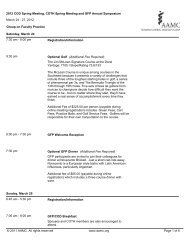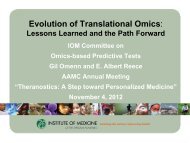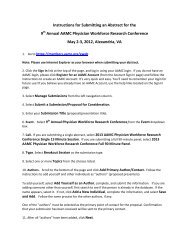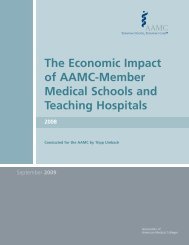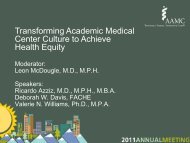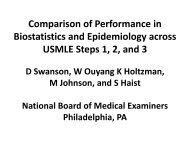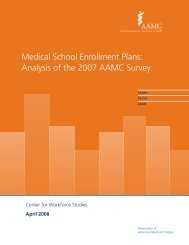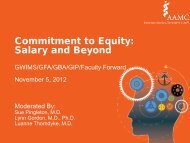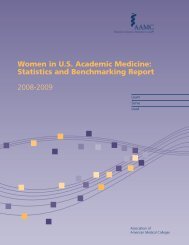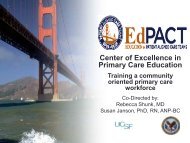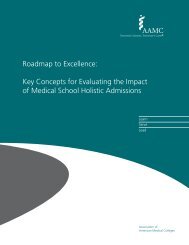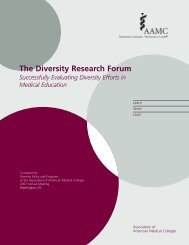Advancing Educators and Education - AAMC's member profile
Advancing Educators and Education - AAMC's member profile
Advancing Educators and Education - AAMC's member profile
Create successful ePaper yourself
Turn your PDF publications into a flip-book with our unique Google optimized e-Paper software.
Scholarship Consensus ConferenceConference MaterialsPre-conference Readings [references]In preparation for the working conference, allattendees were asked to read the articles listedbelow to provide a common foundation fromwhich to “build on what is known” about educationalscholarship. Prior to reading the articles, weadvised all participants to read the annotatedsummaries of these articles to frame their detailedreading of the primary reading-list articles within abroader context.Preparatory Reading Summaries(Prepared by Janet Hafler, Ph.D.)Primary Readings1. Hafler JP, Blanco MA, Fincher RM, Lovejoy FH,Morzinski J. <strong>Education</strong>al Scholarship. Chapter 14. In:Fincher RM (Ed). Guidebook for Clerkship Directors,3rd edition. Alliance for Clinical <strong>Education</strong>.http://familymed.uthscsa.edu/ACE/guidebook.htmThe authors emphasize that, since the CarnegieFoundation’s <strong>and</strong> Boyer’s work, the educationalcontributions of clerkship directors <strong>and</strong> other clinicianeducators are increasingly being recognized <strong>and</strong>rewarded in medical education. Boyer’s l<strong>and</strong>markpublication helped educators organize their workwithin a new framework he labeled “scholarship.” Inthis chapter, the authors provide a practical underst<strong>and</strong>ingof the scholarship of education so that theycan benefit <strong>and</strong> advance based on their work asscholars. The daily activities of clerkship directors,such as teaching, mentoring, curriculum development,or educational leadership, are now recognizedas scholarship under certain circumstances.The authors first provide an overview of educationalscholarship <strong>and</strong> then describe an archetypicalcase to illustrate the main concepts <strong>and</strong> guide clerkshipdirectors’ practical underst<strong>and</strong>ing of the scholarshipof education. Subsequent sections provideinformation on how to move an educationalactivity into a scholarly activity <strong>and</strong> then intoscholarship. Specific delineations between scholarlywork <strong>and</strong> scholarship are covered next, followed bya dialogue on how one’s work can be evaluated. Theauthors finish with a discussion about supportsystems at the institutional <strong>and</strong> department levels.2. Rice RE. Scholarship Reconsidered: History <strong>and</strong>Context. Chapter 1. In: O’Meara K, Rice RE. FacultyPriorities Reconsidered: Rewarding Multiple Forms ofScholarship. San Francisco: Jossey-Bass 2005. Pp. 17–31.Rice highlights that Scholarship Reconsidered becamea significant document because it came at the righttime <strong>and</strong> addressed the main strains developedaround central issues of faculty scholarly work thatshould be valued <strong>and</strong> rewarded. The primary goal ofthe report was to extend the debate across highereducation, create new conceptions of faculty workin a way that would reintegrate personal <strong>and</strong> institutionalpriorities, <strong>and</strong> bring a new kind of wholenessto what it means to be a scholar while respondingmore adequately to the shifting educational needs ofsociety. Rice describes the changing context <strong>and</strong>external events that affected the way we think aboutscholarship. He argues that, while most highereducation reforms begin on the margins of theinstitution, Scholarship Reconsidered targeted thecenter of the academic enterprise by beginning withthe faculty role <strong>and</strong> questioning the meaning ofscholarship <strong>and</strong> the academic reward system. Ricepoints out the influence of Boyer’s charismatic <strong>and</strong>positional authority <strong>and</strong> that of the AmericanAssociation for Higher <strong>Education</strong> <strong>and</strong> the CarnegieFoundation that supported the report <strong>and</strong> extendedits impact. The author describes the debate generatedaround “scholarship of teaching,” including themove toward adopting the more inclusive “scholarshipof teaching <strong>and</strong> learning,” as well as the distinctionsamong good teaching, scholarly teaching, thescholarship of teaching <strong>and</strong>, most recently, “thescholarship of engagement.”3. Huber MT, Hutchings P, Shulman, LS. The Scholarshipof Teaching <strong>and</strong> Learning Today. Chapter 2. In:O’Meara K, Rice RE. Faculty Priorities Reconsidered:Rewarding Multiple Forms of Scholarship. SanFrancisco: Jossey-Bass 2005. Pp. 34–38.17Association of American Medical Colleges, 2007



